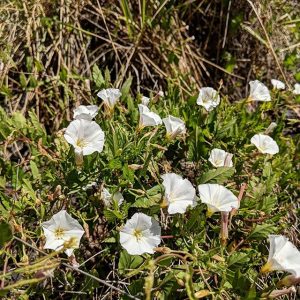Common or Field Bindweed (Convolvulus arvensis), a Eurasian morning glory and a persistent weed of cereal crops and urban waste grounds. Also comes more strongly striped in pale pink.
Field Bindweed was first recorded in Australia at Hobart in 1877, in the southeastern highlands of NSW in 1884, and west of Hamilton in Victoria in 1892, reflecting likely repeated introductions in contaminated imports of seed. By 1904 the plant had turned up within the metropolitan (at Altona).
With a perennial root system resistant to typical herbicide applications, and a seed bank persistent to at least 20 years, Field Bindweed is difficult to eradicate once established. A noxious weed in the cereal belt, as shown in the photographs it will also take advantage of twining opportunities where available. In Melbourne, it is an occasional colonist of rocky ground or aggregate layers where a thicker, excluding groundcover or shrub layer is unable to establish. Field Bindweed may displace the state’s nine native bindweed species wherever it can gain access to similar niches in natural environments.
View Original Post on Instagram
Search for information about Convolvulus arvensis in the Flora of Victoria
View information and occurrences of Convolvulus arvensis on the Atlas of Living Australia











